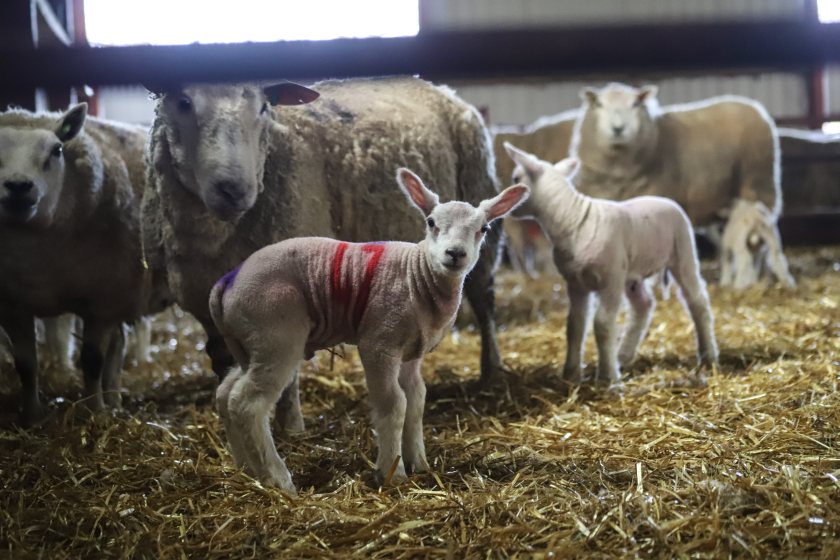
A group of livestock farmers is collectively capturing feed savings of £26,000 a year across their sheep flocks by increasing the metabolisable energy (ME) value of their silage.
The Hiraethog Discussion Group, facilitated by the Welsh government's Farming Connect scheme, has been collectively working to improve the quality of silage to reduce purchased feed costs.
To achieve this, the farmers have incorporated more clover into grass leys and improved attention to detail in the silage making process, from getting the cutting dates and wilting times right to how bales are wrapped and handled or in how the clamp is consolidated.
With advice from livestock specialists over a three-year period, these measures have resulted in the ME value of baled silage across the group increasing from 9.6MJ ME/kg dry matter (DM) to 10.6.
That additional 1MJ ME/kg DM is worth £4/ewe pre-lambing, calculated independent sheep expert Kate Phillips, one of the consultants who has been advising the group.
This is because each 1MJ (ME) is the equivalent of feeding 10kg of concentrate/ewe, she said.
“At a cost of £400/tonne for sheep concentrate, that is equivalent to £4/ewe which, on a typical 500-ewe system, that's £2,000," said Mrs Phillips.
The combined savings across discussion group – farms in Conwy with approximately 6,500 ewes between them – works out at £26,000.
In the clamp silage, the ME value increased from 10.2 to 10.7 and crude protein from 12.2% to 14%.
Mrs Phillips said good quality silage needs to be well made - above 25% DM ideally, a pH of not less than four, low ammonia, very low butyric acid and the ME appropriate for the class of stock being fed.
“For ewes in late pregnancy, ME should be 10.5MJ/kgDM or better and crude protein 12% or higher,’’ she said. “Lower quality silage is more appropriate for dry suckler cows."
One of the factors that contributed towards the higher quality silage produced by the Hiraethog Discussion Group was a deeper understanding of the stages of grass maturity.
As a rule, digestibility (D)-value in the grass plant falls by 0.5 units a day from when it starts to push up flowering stems, said group facilitator Guto Owen, Farming Connect development officer for Conwy.
The group focussed on fertiliser application too, with advice on fertiliser utilisation; under ideal growing conditions, grassland can utilise 2.5kg nitrogen (N)/hectare (ha) a day.
The farmers learned the importance of ration planning too, from Mrs Phillips as well as nutritionist Hefin Richards and sheep and beef specialist Dr Liz Genever.
Dr Genever said analysing the nutrient value of silage provides the foundation for getting the ration right.
“Silage analysis is vital in assessing likely nutritive values of what a farmer has ‘in the bank’ for the winter," she explained.
Through ration planning, its use can be targeted according to stock demand.
And by improving forage quality and yield, farmers can reduce their reliance on nitrogen (N) fertiliser.
Mr Richards said clover had a role to play too, by providing free N and higher protein forage.
The discussion group members have also tapped into Farming Connect services to help them make the improvements.
For example, one farmer had two Nutrient Management Plans drawn up during the current Farming Connect programme.
“The second allowed me to see the improvements made from actioning the recommendations made in the first," he said.
An on-farm clinic in the spring of 2022 had also given him the opportunity to get his questions answered by the visiting consultant, to gain advice on manure application and its potential nutrient value for silage crops.
He had benefitted from peer support too and the advice of the consultants, he added.
“This has led me to increase my knowledge on soil health, in turn, this has resulted in better crop yields and improved forage quality in the past few years," he said.
This winter, his in-calf suckler cows won’t need any supplementary feed as the ensiled forage is of sufficient quality.
“Significant savings will also be made in feeding our in-lamb ewes," he said.
Some of the group members had received Farming Connect-funded one-to-one advice on rationing from Mrs Phillips – a service that is still available to businesses registered with Farming Connect.
Gaining advice from several people on a range of specialisms will help farmers to develop their businesses, said Mr Owen, adding: “Small changes lead to big gains."
But it was not just the advice of experts that had been important – members of the Hiraethog Discussion Group have benefited greatly from each other’s advice too.
This, said Mr Owen, had been a crucial reason why the group had been so successful.
“The group has regular chats on the group WhatsApp, seeking advice and sharing ideas, the good the bad and the ugly," he said.
